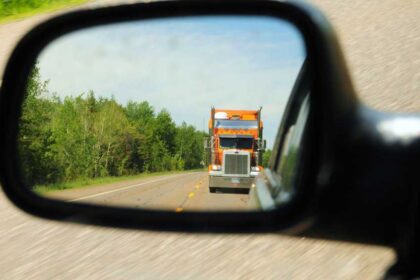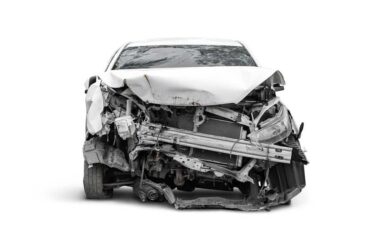Defensive Driving is key when sharing the road with Semi-Trucks

With a weight nearing 80,000 lbs. and a length of 60 to 80 feet, of course big rigs instill a sense of fear among other motorists. So, if you find yourself clutching the wheel tighter when defensive driving around a semi-truck, you are certainly not the only one.
The massive dimensions of these vehicles pose a very different set of challenges for the individuals who pilot these juggernauts. So, learning about how semi-truck drivers do things differently and what they need to keep themselves and the motorists around them safe will help you to keep yourself and others from harm’s way. Let’s start with the most important question-
What makes a heavy truck so different and so hard to drive?
1. The large size equates to slower reactions: A lot of motorists harbor the misconception that truckers deliberately hold up traffic and block lanes. In reality, a truck driver has to merge as quickly as possible when entering the highway, otherwise he will run out of room in the merge lane. If the big rig is already in the traffic, moving over to accommodate merging vehicles is not an option for truckers. And, that’s usually how and why smaller vehicles get run off the road by trucks.
2. The long length equates to smaller field of vision: A semi-truck has blind spots on all four sides unlike a regular passenger vehicle. So, it is easy for another motorist to end up in a spot where the trucker cannot see them at all.
3. The weight and length impact stopping time and distance: A car travelling at 65 mph needs 300 feet to come to a complete stop after the brakes are deployed. A heavy truck needs twice this stopping distance. Assuming that that trucker is very alert and discounting the lag required for the air brakes to do their job, it would still be 6 seconds before the tires of the rig come to a screeching halt.
4. The need for more space: Depending on the length of the trailer and the angle of turn, trucks can need anywhere between 17 to 35 feet of space to turn. In fact, most truckers will try to have at least 3 to 5 lanes worth of road before they initiate a turn.
5. Greater exposure to wind movement: Big rigs can have as much as 500 feet of sail area when, you consider their greater height and length. So, semis have a significant wind vulnerability, particularly when the wind hits the vehicle at a 90-degree angle and wind speeds exceed 40 mph. Truck rollovers, lost loads, jack knife accidents are all known to occur in high wind conditions.
Practice defensive driving techniques around semi-trucks.
1. Know the rules of passing: Remember these vehicles are big and they are slow. So, give them enough room and time to pass. Get your foot off the gas and stick to the far right. This will give the trucker enough room and time to pass around you.
When you need to do the passing, be as fast as possible, while maintaining your speed. The last thing you want to do is slow down. Also, if you intend to pass a truck, don’t do it on a downgrade because these heavy vehicles pick up significant speed while going downhill.
So, you will have to go faster than intended to come out well ahead of the truck. Moreover, in case of a problem, it will take the trucker that much longer to stop. That’s a double whammy and thus best avoided.
After making the pass, do not decelerate while in front of the truck. Your aim should be to keep a distance of ten car lengths between your rear bumper and the big rig behind you. This will keep you out of the trucker’s blind spot and give him enough time to stop in case of trouble.
2. Know the blind spots and stay out of them: On the left, i.e., the driver’s side, the blind spot is one lane wide and extends from the cab to a few feet beyond the half the length of the trailer.
On the right, i.e., the side opposite to the driver’s seat, the blind spot is 2 lanes wide and extends beyond the length of the trailer.
In addition, the trucker cannot see you if you are 20 feet in front of the bumper of the truck and 30 feet behind the trailer.
Try very hard to not get into these blind spots. If you do inadvertently find yourself in these no-zones, get out of them as fast as possible.
3. Know your own game: Don’t cut in front of a truck, certainly not in a way that lands you in the truck’s safety-zone, which is the space in between the rig and the car in front of it. If you are overtaking a truck, make sure that you can see the headlights of the rig in your rearview mirror before moving directly into the center of its lane.
Use your turn signals well in advance if you see a big rig around you. This will give the trucker enough time to react in response to your intended maneuver. These vehicles are bulky and slow, so give them space and the right of way where possible by slowing down and accommodating their need to merge with the traffic.
4. Know the importance of rules: Considering the fact that there are 2 million registered tractor-trailers in the US and over half of them are on the road at any given time, you are likely to encounter one of these massive vehicles every time you are out and about.
Traffic rule/signal violations carry a big risk at all times but they can be outright dangerous and life threatening when in the vicinity of a big rig. The problem is that truckers are expecting you to stick to the norm when it comes to driving practices. And when you do something out of the ordinary like going through a stop-sign or changing lanes suddenly or driving too fast, you are bound to surprise the truck driver.
Unfortunately, no matter how fast he reacts, his vehicle will not be as quick as him to respond. So, obey all rules of the road and practice defensive driving techniques. This makes you predictable to the other motorists, including truckers, and makes the roadways safer for everybody.
5. Know what everybody should know
Last but not the least, distraction and inattention kill more motorists and their passengers than trucks ever can. Unwavering focus is the single most important factor when it comes to sharing the road safely with big rigs.
Of course, it goes without saying that the road ahead will not get your full attention if you are driving in an intoxicated state. As far as drunk driving collisions go, motorists are implicated far more often than truckers are for these life-threatening lapses.
Also, remember to be both patient and courteous when on the road with heavy trucks. Honking, driving aggressively, weaving through traffic, and cussing at the truckers is not going to get you home faster. It may get you to the ER on the double!
The last thing you want is an angry and distracted trucker on the same road as you. Truckers don’t derive pleasure out of holding up traffic. The fact is that often these trucks have speed limiters, which means the truck driver has no choice but to go slow. So, the best approach is to be patient and to be aware of your surroundings at all times.
Wrecks can happen even to the most cautious of motorists!
No matter how cautious you are, wrecks can sometimes happen through no fault of yours. Sadly, big rig collisions often involve significant and even life-threatening injuries for passengers and motorist of smaller vehicles.
The biggest problem is that multiple parties may share accountability for crashes involving heavy trucks. However, like any corporate behemoth, trucking companies go out of their way to cover their tracks. So, proving fault can be very complicated.
With DeVaughn James Injury Lawyers on your side, you’ll have decades of experience handling personal injury cases of big rig collision victims. If you have been injured in such a crash, you are entitled to receive compensation for:
- Your medical expenses
- Lost income
- Pain and suffering
- Wrongful death
We will protect your rights and pursue your case so that you receive fair compensation. Contact us today, so our lawyers can start investigating the collision and collecting the evidence that can turn the tide in your favor.









